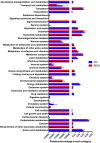Supplemental thymol and carvacrol increases ileum Lactobacillus population and reduces effect of necrotic enteritis caused by Clostridium perfringes in chickens
- PMID: 28779076
- PMCID: PMC5544757
- DOI: 10.1038/s41598-017-07420-4
Supplemental thymol and carvacrol increases ileum Lactobacillus population and reduces effect of necrotic enteritis caused by Clostridium perfringes in chickens
Abstract
Necrotic enteritis (NE) caused by Clostridium perfringens is one of the most detrimental infectious diseases in poultry. This study examined the effect of blends of essential oils (BEOs) (25% thymol and 25% carvacrol) on NE and bacterial dynamics and functions in chicks challenged with C. perfringens. Chicks were assigned to a Control diet and BEOs diet (Control diet + 120 mg/kg BEOs), were challenged with C. perfringens from days 14 to 20 and were killed on day 21 for assessment. Supplementation with BEOs decreased the mortality, alleviated gut lesions, and decreased the virulence factors of pathogenic bacteria (VF 0073-ClpE, VF0124-LPS, and VF0350-BSH). Lack of supplementation also changed the nutrient and immunological dynamics of host microbiota in responding to C. perfringens infection. Adding BEOs changed the host ileum microbial population by increasing the numbers of Lactobacillus crispatus and Lactobacillus agilis, and decreasing Lactobacillus salivarius and Lactobacillus johnsonii. The functional roles of these changing host bacterial populations coupled with the putative reduced pathogenicity of C. perfringens by BEOs contributed to the reduction in gut lesions and mortality in infected chickens. It suggests that dietary supplementation with BEOs could significantly reduce the impact of NE caused by C. perfringens on broilers.
Conflict of interest statement
The authors declare that they have no competing interests.
Figures










Similar articles
-
Effect of encapsulated carvacrol on the incidence of necrotic enteritis in broiler chickens.Avian Pathol. 2016 Jun;45(3):357-64. doi: 10.1080/03079457.2016.1138281. Avian Pathol. 2016. PMID: 27245304
-
Analysis of gut microbiota and the effect of lauric acid against necrotic enteritis in Clostridium perfringens and Eimeria side-by-side challenge model.PLoS One. 2019 May 31;14(5):e0205784. doi: 10.1371/journal.pone.0205784. eCollection 2019. PLoS One. 2019. PMID: 31150394 Free PMC article.
-
Exploring the interactive impacts of citronellol, thymol, and trans-cinnamaldehyde in broilers: moving toward an improved performance, immunity, gastrointestinal integrity, and Clostridium perfringens resistance.J Appl Microbiol. 2024 Oct 3;135(10):lxae206. doi: 10.1093/jambio/lxae206. J Appl Microbiol. 2024. PMID: 39122661
-
Microbial shifts associated with necrotic enteritis.Avian Pathol. 2016 Jun;45(3):308-12. doi: 10.1080/03079457.2016.1152625. Avian Pathol. 2016. PMID: 26950294 Review.
-
Necrotic enteritis predisposing factors in broiler chickens.Avian Pathol. 2016 Jun;45(3):275-81. doi: 10.1080/03079457.2016.1150587. Avian Pathol. 2016. PMID: 26926926 Review.
Cited by
-
Protective Effects of Natural Antioxidants on Inflammatory Bowel Disease: Thymol and Its Pharmacological Properties.Antioxidants (Basel). 2022 Sep 29;11(10):1947. doi: 10.3390/antiox11101947. Antioxidants (Basel). 2022. PMID: 36290669 Free PMC article. Review.
-
Oregano powder reduces Streptococcus and increases SCFA concentration in a mixed bacterial culture assay.PLoS One. 2019 Dec 10;14(12):e0216853. doi: 10.1371/journal.pone.0216853. eCollection 2019. PLoS One. 2019. PMID: 31821320 Free PMC article.
-
Microencapsulation Improved Fumaric Acid and Thymol Effects on Broiler Chickens Challenged With a Short-Term Fasting Period.Front Vet Sci. 2021 Oct 15;8:686143. doi: 10.3389/fvets.2021.686143. eCollection 2021. Front Vet Sci. 2021. PMID: 34722691 Free PMC article.
-
Modulation of Growth Performance and Intestinal Microbiota in Chickens Fed Plant Extracts or Virginiamycin.Front Microbiol. 2019 Jun 18;10:1333. doi: 10.3389/fmicb.2019.01333. eCollection 2019. Front Microbiol. 2019. PMID: 31275268 Free PMC article.
-
Drought-Adapted Mediterranean Diet Plants: A Source of Bioactive Molecules Able to Give Nutrigenomic Effects per sè or to Obtain Functional Foods.Int J Mol Sci. 2024 Feb 13;25(4):2235. doi: 10.3390/ijms25042235. Int J Mol Sci. 2024. PMID: 38396910 Free PMC article. Review.
References
-
- Wade, B. & Keyburn, A. The true cost of necrotic enteritis. http://www.poultryworld.net/Meat/Articles/2015/10/The-true-cost-of-necro... (2016) (Date of access:09/10/2015).
-
- Stackebrandt, E. & Rainey, F. A. Phylogenetic relationships. In The Clostridia - molecular biology and pathogenesis (ed. Rood, J. I., McClane, B. A., Songer, G. & Titball. R. W.) Chapter 17 (1997).
-
- Bryant, A. E. & Stevens, L. S. The Pathogenesis of Gas Gangrene. Academic Press. San Diego. 186–187 (1997).
Publication types
MeSH terms
Substances
LinkOut - more resources
Full Text Sources
Other Literature Sources

